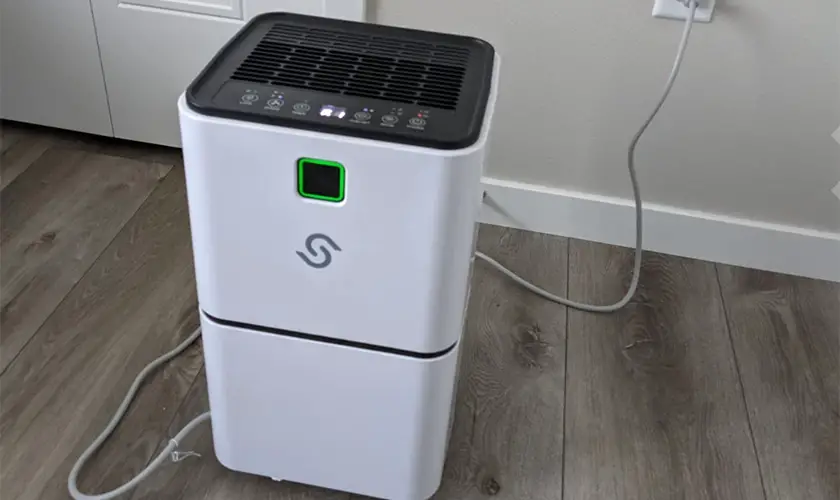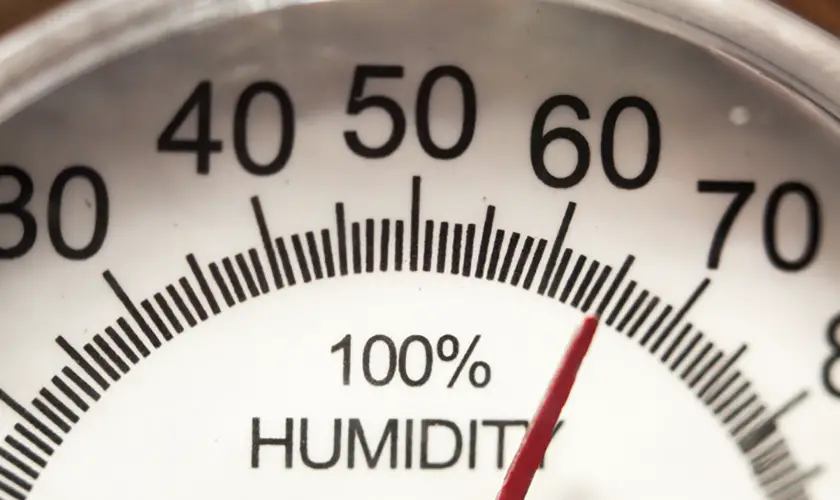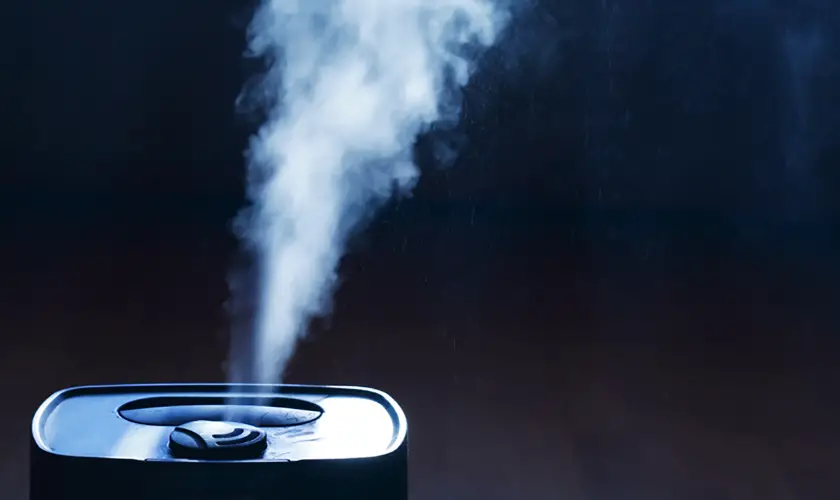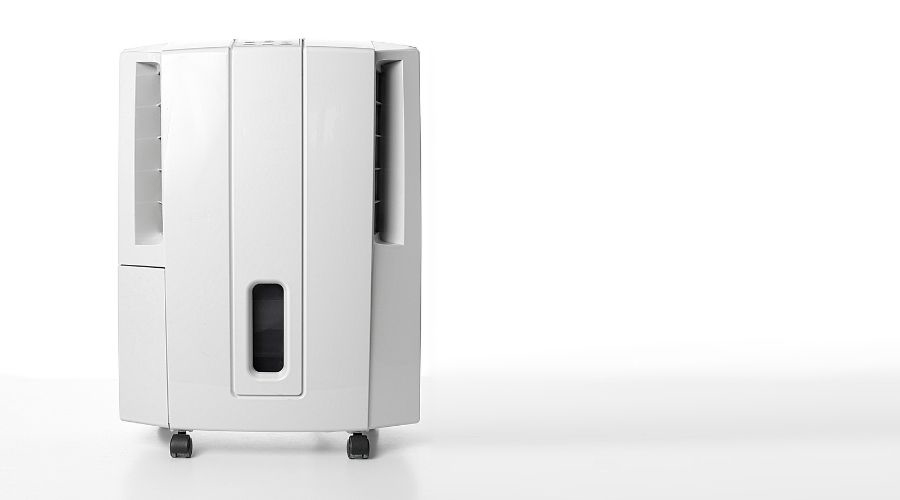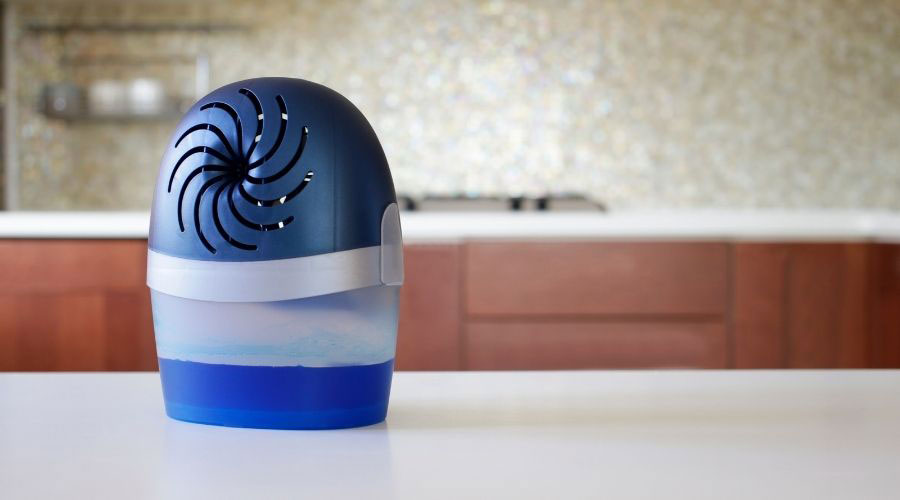
Dehumidifiers are excellent tools are removing moisture in the air. Many homeowners use it to lessen allergens and live more comfortably. Some people even sleep with them in the bedrooms. However, you may be at this article because of your concern about if dehumidifiers cause dehydration.
Dehumidifiers will not cause dehydration, although you may feel that way after a long night’s sleep. These symptoms include dry air, climate, illnesses, lack of water, and food allergies. As a dehumidifier goes, you can set the perfect humidity level between 30-50%, as the device will not drop below.
However, several people still believe that a dehumidifier can dehydrate them. Here, we’re going to debunk all these concerns and prove that a dehumidifier won’t make you dehydrated.
What is Dehydration?
Before we answer whether a dehumidifier causes dehydration or not, let’s first explain what dehydration is.
When your body does not contain enough liquid or water to function adequately, dehydration comes into play. Your body is consuming less water, which could be hazardous to your health.
For example, during physical activity, you lose a lot of water. In other instances, medication, diet, or sweat from the heat can cause this issue. A sickness that causes vomiting, diarrhea, and fever could also lead to water loss.
Since the body experiences a deficiency of electrolytes and carbohydrates and a rise in blood sodium levels, you might suffer from dehydration if you fail to replace the lost fluids. Not only that, but you’ll experience weakness mentally and physically.
Below are symptoms of dehydration that you need to be aware of:
- Dry mouth
- You might feel very thirsty
- Sleepy and fatigued
- Dry eyes without tears
- Dry skin
- Headache
- A reduction in urine frequency
- Dizziness
- Rapid heart pumping
- Low blood pressure
- Yellowish and dark urine compared to the usual output
Can a Dehumidifier be Harmful?
It is no wonder you want to consider buying a dehumidifier! They help maintain your home’s humidity level and protect your personal belongings from rust and getting ruined, such as wallpaper peeling, water stains, and cracked tiles.
You should ask yourself whether it is always safe to operate a dehumidifier. The effects of a dehumidifier have a positive impact on our health. They help to ease difficulties in breathing and reduce the level of humidity.
However, when using a dehumidifier, you’ll need to be mindful if you drink enough water. Although dehumidifiers do not threaten dehydration, they still take moisture from the air, so your skin may become drier.
Be mindful when living in dry areas already, for you may not even need one in the first place. In that case, a humidifier would do you a lot better.
Modern dehumidifiers contain several safety features that enable them to remain safe even when you plug it and leave it operating for extended periods.
We recommend that you only allow your dehumidifier to operate continuously at 60% and above high humid conditions.
Once the level is below 60%, you can vary the dehumidifier’s working duration depending on your body condition and preference.
However, you don’t need to worry since most modern dehumidifiers can operate for an extended period. If the tank reaches enough water, the dehumidifier will shut off automatically to restrict an overflow until the tank empties.
Some dehumidifiers are designed with an anti-tilt feature to stop themselves from functioning as soon as it’s pushed off balance to the ground, thus keeping you safe. The motor will also shut down when the dehumidifier overheats.
Because of the above features, dehumidifiers are safe to run and use. However, you must ensure that the device doesn’t drop the atmospheric humidity below 30%. A shallow humidity level could pose adverse effects.
Is it Okay to Sleep in a Room with a Dehumidifier?
Yes, it’s okay to spend the night in a room that has a dehumidifier. However, you should ensure the noise level is perfect, especially when dehumidifying your bedroom.
For some time now, people have been using dehumidifiers to improve their night’s sleep.
How Humidity Affects Sleep
- It affects comfort: People prefer sleeping in a room with less humidity. In most cases, humidity can negatively impact your quality, comfort, and allergies.
- Humidity affects breathing: As far as comfort is concerned, you won’t feel comfortable sleeping in a musty and damp environment. Humidity also makes your breathing difficult, especially while sleeping.
- Encourages dust mites & mold: High humidity encourages the growth of dust mites, mildew, and mold, which triggers allergies. It becomes difficult to fall asleep with allergies.
How a Dehumidifier Helps You Sleep Better
In case you still don’t know, the function of a dehumidifier is to reduce the level of water vapor or humidity in the environment. The dehumidifying process creates an atmosphere that feels a bit cooler and relatively dry.
The machines are somehow related to air conditioners. The moist and warm air surrounding the dehumidifier gets into the machine and moves down the cooling coils. Therefore, it leads the atmosphere’s moisture to condense on the machine’s coils.
The condensed water will then drip and get collected in a container.
Perfect Humidity Level for Sleep
There is no specific humidity that everyone agrees to be the ideal level for sleep. After all, some people prefer lower humidity levels, and others prefer a slightly higher humidity level.
However, the perfect humidity for sleeping is about 45%. The ideal temperature is 30-50 percent.
If you sleep in a low humidity of about 20%, you might experience a dry throat, eyes, and nose. You’ll end up waking up with significant discomfort.
Modern dehumidifiers are designed with improved technology to create perfect humidity for your room. The functionality lets you set the dehumidifier to a specific humidity level of choice in the 30-50% humidity range.
The Design of a Dehumidifier
A dehumidifier has almost a similar design to an air conditioner. However, a dehumidifier has two coil sets in a conditioned space. Air conditioners feature a condensing coil outside and an evaporating unit inside the device.
A significant difference between an AC and a dehumidifier is how air flows over the coils. The air moves over the coils at a slower rate than a dehumidifier. In this case, the air gets enough time to remove its moisture load.
Most dehumidifiers are also stand-alone devices, unlike air conditioners. They are therefore not designed to be ducted.
Dehumidifiers are relevant if you have high humidity challenges in your home. High humidity is known for causing aggravated health conditions and black mold. The excess moisture also causes damage to the furnishings, ceilings, and walls.
Signs Your Home Requires a Dehumidifier
Before you consider the drawbacks of a dehumidifier, there is a need to consider your surroundings. You’ll need a dehumidifier if you notice any of the below in your home:
- You notice mildew spots on the walls and ceilings
- There is condensation on the windows and walls
- When the wallpaper is peeling
- You identify watermarks in the basement
- The floor or beams present rotting wood
- When there is a musty smell in your home
Even though some of the above signs might show the need to dehumidify your home, it still isn’t reason enough to rush out and purchase a device.
You can proceed to check the humidity level using a hygrometer. If the hygrometer records an amount of 50%, find out the cause of the high humidity.
Other Measures to Dehumidify Your Home
If you determine the problem is from your bathroom, we recommend opening the windows while showering. You can heat the space to dry air if it’s from the basement. The below tips can help you reduce the moisture level:
- Open windows and turn on fans to your house where you cook and shower.
- Apply lids on pans when boiling water.
- Remove houseplants from your home since they emit water vapor.
- Use a heater or radiator to heat your living space.
- Make sure you properly vent your washing machine.
- Keep the bedroom door open to remove moisture from breathing while you sleep.
- Dry clean standalone carpets and rugs since they accumulate moisture.
- Use caulk along cracks to seal your home.
- Apply charcoal or rock salt to absorb excess moisture.
Even after you have employed the above measures, it’s still crucial that you check your hygrometer. You’re likely to find that the approaches reduce the moisture level in your home.
If the moisture level is above what you expected, you need to consider buying a dehumidifier. However, you must review the drawbacks of a dehumidifier to know what to expect while using the device.
What are the Pros & Cons of a Dehumidifier?
Now that we understand the design of a dehumidifier, it will help you decide whether you need one in your household or not.
A dehumidifier is for people who experience mildew or mold challenges and those who suffer from allergies. In such a case, the device brings comfort and peace of mind. However, we will dive into both the advantages and disadvantages of a dehumidifier below.
| PROS | CONS |
|---|---|
| It helps assist with allergies. | It is high in electric bill costs. |
| It helps to reduce pet-related challenges. | It can be extremely noisy. |
| Controls moisture levels. | They can emit warm air. |
| A dehumidifier improves comfortability. | It can cause the air to dry up. |
| Saves energy and cost of air conditioners. | It may require maintenance if it does not contain a hose. |
Drawbacks of a Dehumidifier
1. Cost of Electricity
If your device is constantly left on, then the cost of energy required to operate them is a considerable drawback. If that is the case, you’ll see a significant difference in your electric bill.
However, you can easily purchase an air-efficient dehumidifier to help with your bills. If that is the case, it may be worth spending a little extra money to ensure you save more in the long run.
On the other hand, if you have a tight budget, then an energy-efficient dehumidifier may be a challenging road to get there.
2. Noise Levels
Another disadvantage is the humming noise that dehumidifiers generate. Most dehumidifiers emit background noise while operating, which can be very annoying, especially at night. For instance, some dehumidifiers generate noise of 20-50 dB.
If you don’t like noise, you can consider purchasing a desiccant dehumidifier. Such a type of dehumidifier generates less noise. However, it was more expensive.
3. Heat
If you have a relatively cold home, getting a dehumidifier can help resolve that issue. Not only are you saving money on heating bills, but you are warming yourself and your family up in the process! Warming the air is especially true if you purchase a desiccant dehumidifier.
However, go for the compressor dehumidifier if you live in a warmer climate.
4. Dry Air
Dehumidifiers can make the air dry. That is not good as it can worsen some conditions like eczema and pneumonia. Dry hair also affects the hair and skin. A dehumidifier will only heighten the dry climate if you live in a dry place.
5. Maintenance
Dehumidifiers need two forms of maintenance that can be difficult at times:
- Emptying the water tank: The dehumidifying water tank requires emptying at least once weekly. It can even be twice a day, depending on your model. To avoid this monotonous feeling, you can purchase a device with a continuous drain hose.
- Cleaning the filter: You need to check the manufacturer’s manual to understand how to clean the filter.
Benefits of a Dehumidifier
It would help if you bought a dehumidifier to enjoy the following benefits.
1. Assists With Allergies
You should be in favor of anything that can get rid of mold, mildew, and dust mites! Rooms with poor air circulation are excellent places to put your dehumidifier.
Other rooms, such as bathrooms, laundry rooms, basements, mudrooms, etc., are where you’ll see the most allergy-causing elements.
A dehumidifier helps prevent bacteria growth, reduces moisture, encourages allergen growth, and improves air quality.
2. Reduces Pest-Related Challenges
There are pests such as cockroaches and spiders that like moist environments. For such bugs, a dehumidifier will help to discourage their spread. You need to pay more attention to rooms that have more insects.
3. Controlling Moisture Levels
No one wants to sweat while enjoying the comfort of their home. One of the primary purposes a dehumidifier has is to control moisture levels.
As mentioned above, you can easily manage the humidity level with a thermostat a dehumidifier has to offer.
You might even experience the destruction of furniture as a result of long-term humidity. A dehumidifier will decrease the moisture in your home, thus limiting such problems.
4. Improves Comfort
Homes with the correct humidity levels offer more comfort, especially when sleeping at night. The indoor air quality is improved if you have a dehumidifier.
5. Saves Energy Costs of Air Conditioners
With dehumidifiers, you can control the energy costs by enabling the air conditioner to work effectively. Since the dehumidifier removes moisture from the environment, the air conditioner won’t use energy to maintain the required temperature.
If you purchase Energy Star-certified dehumidifiers, you’ll save up to 15% of energy to operate.
Considerations While Buying a Dehumidifier
You must consider factors if you want to purchase a reliable and effective dehumidifier. Let’s go through these factors below:
1. Your Needs
You need to ask yourself why you need a dehumidifier in the first place. Health experts recommend that those suffering from allergy and asthma can minimize or avoid their symptoms by reducing the moisture content within their environment.
Less moisture also means mildew, dust mites, bacterial growth, and mold. Even if you’re without any medical concerns, dehumidifying improves your comfort level, especially when you’re sleeping at night.
2. The Type of Dehumidifier
There are two popular types of dehumidifiers: desiccant and compressor. The main difference between the two is their practicality while running at lower vs. higher temperatures.
- Desiccant dehumidifier: A perfect solution for colder environments.
- Compressor dehumidifier: Preferred for an area with higher temperatures.
Select the type of dehumidifier that fits your needs.
3. The Required Space to be Dehumidified
The capacity of the dehumidifier you need to purchase should depend on the amount of space in question. The dehumidifier capacity measured in a pint calculates the amount of moisture that the device can remove from the air within 24 hours.
Select a dehumidifier that is perfect for the size you intend to dehumidify. Dehumidifiers are classified according to size as below:
- Small dehumidifier: For small bedrooms, closets, bathrooms, etc.
- 30-pint dehumidifier: For bedrooms & bathrooms.
- 50-pint dehumidifier: For medium-sized bedrooms & bathrooms with a shower.
- 70-pint dehumidifier: For large rooms & basements.
- Commercial dehumidifier: For larger buildings.
4. Humidity Level & Indoor Temperature
The indoor temperature and humidity levels are critical factors that affect the performance of your dehumidifier. A higher humidity level requires you to have a high-capacity dehumidifier. The devices also reach their capacity quickly when exposed to high-humidity conditions.
5. Special Features
The type of dehumidifier you purchase will also depend on whether or not you require additional features. Some of the key elements you need to check out include:
- Timer
- User-friendly controls
- Constant drainage
- Washable air filter
- Integrated humidistat
- Auto-restart
- Hose connection
6. The Location of the Dehumidifier
Dehumidifiers are perfect for any space in your workplace or home, including bedrooms, basements, bathrooms, laundry rooms, closets, kitchens, crawl spaces, and living rooms. After choosing the ideal dehumidifier capacity and size, you must ensure that the device has the proper airflow.
7. The Cost
The price of a dehumidifier varies depending on different factors, including capacity, size, portability, and durability. For instance, refrigerant dehumidifiers are cheaper than desiccant-based models.
However, don’t shy away from spending an extra amount on an effective and reliable dehumidifier.
8. The Brand of the Dehumidifier
You’ll be guaranteed effective performance if you settle on a reputable dehumidifier brand. Some reputed brands include Kenmore, Haier, LG, GE, and Whirlpool.
However, ensure you go for an energy-efficient model that meets your needs. Most models are certified for energy efficiency.
Conclusion
As highlighted above, there is no chance of a dehumidifier causing dehydration even if you operate it through the night.
The purpose of dehumidifiers is to absorb moisture from the air. You must set your device to a perfect humidity level of 30-50%.
Even though a dehumidifier has some drawbacks highlighted above, it also presents several benefits you need to take advantage of. Before you buy a dehumidifier, consider the factors we have highlighted above.


